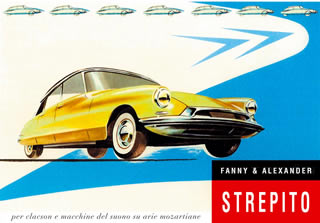
|
|||||

from the project Heliogabalus
sound devices: Mirto Baliani
dramaturgy: Chiara Lagani
costumes: Chiara Lagani, Sofia Vannini
lighting design, video, direction: Luigi de Angelis
scenery and technical realization: Luigi de Angelis, Francesca Merciari
with: Gerardo Lamattina
promotion: Marco Molduzzi, Valentina Ciampi
press office: Marco Molduzzi
logistics: Sergio Carioli
administration: Antonietta Sciancalepore, Marco Cavalcoli
production: Fanny & Alexander
music from Le Nozze di Figaro, Die Zauberflöte, Don Giovanni, Requiem
inspired by Tommaso Landolfi's "Gogol''s wife"
with thanks to Matteo Ramon Arevalos, Pietro Babina, Silvia Calderoni, Fabio Dalla, Elisa Eusebi, Antonio Martini, Francesca Montanari per Ratmusqué, Antonio Rinaldi
For the project Heliogabalus, which made its début in Belgium in Leuven and Antwerpen in February 2006, we assembled a little orchestra of compressed air hooters from cars and trucks, to accompany in a noisy manner the ruinous rise of the adolescent emperor from the East... The music’s choice was conditioned by Kierkegaard’s fundamental essay on eroticism in W.A. Mozart’s works and the three stages or phases of desire corresponding to the three key figures (page Cherubino, Papageno and Don Giovanni) in Le Nozze di Figaro, Die Zauberflöte, Don Giovanni.
Our very first idea for Strepito was to render all the materials we collected then, even the ones that were excluded from the show afterwards, in order to unfold the whole parable of the three stages of musical desire (dreaming, seeking, desiring) we started from in our attempt to steal the elusive figure of our Varius Heliogabalus from the darkness of its myth.
The three operas’ ouvertures and main arias are performed by an orchestra of compressed air hooters from cars and trucks, managed by a MIDI interface and two compressors and accompanied by electronic re-elaborations of the scorings, that are spread by means of sound devices.
More due to climatic assonance than thematic similarity, soon this first idea was entwined and mixed with a different narrative level, inspired by a well-known short story by Tommaso Landolfi, Gogol''s wife. In this short story the famous Russian writer's wife is a plastic-made love doll, metamorphic object of desire, of a love that's impossible to define, to realize, even to conceive. In Strepito A, a not better defined character, maybe a garage hand, maybe a mechanic, inflates and deflates some love dolls inside what seems to be a garage. As a matter of fact, we become witnesses of these obsessive acts only by means of some video images, maybe from a closed circuit telecamera. A display renders the texts of Mozart's arias, interweaved with the short story by Landolfi. The garage’s window reflects the lights and the still shadow of another character, B, the "spectator of this love", who silently watches like us, he watches and he is watched.